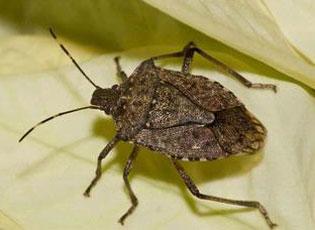Halyomorpha halys Stål (ITIS)
Brown marmorated stink bug (BMSB)
East Asia (Gariepy et al. 2014)
First confirmed in 2001 in Allentown, Pennsylvania, but specimens were collected as early as 1996 (Khrimian et al. 2008)
Possibly arrived in shipping material (Gariepy et al. 2014)
Feeds on a variety of plants, including fruit trees, ornamentals, and some crops (Gariepy et al. 2014)

Brown Marmorated Stink Bug, Adult
Photo by Susan Ellis
Spotlights
Distribution / Maps / Survey Status
Videos
All Resources
Selected Resources
The section below contains highly relevant resources for this species, organized by source.
Council or Task Force
Partnership
Federal Government
International Government
State and Local Government
Academic
Gariepy, T.D., T. Haye, H. Fraser, and J. Zhang. 2014. Occurrence, genetic diversity, and potential pathways of entry of Halyomorpha halys in newly invaded areas of Canada and Switzerland. Journal of Pest Science 87(1):17-28.
Integrated Taxonomic Information System. Halyomorpha halys. [Accessed Mar 24, 2023].
Khrimian, A., P.W. Shearer, A. Zhang, G.C. Hamilton, and J.R. Aldrich. 2008. Field trapping of the invasive brown marmorated stink bug, Halyomorpha halys, with geometric isomers of methyl 2,4,6-decatrienoate. Journal of Agricultural and Food Chemistry 56(1):197-203.
